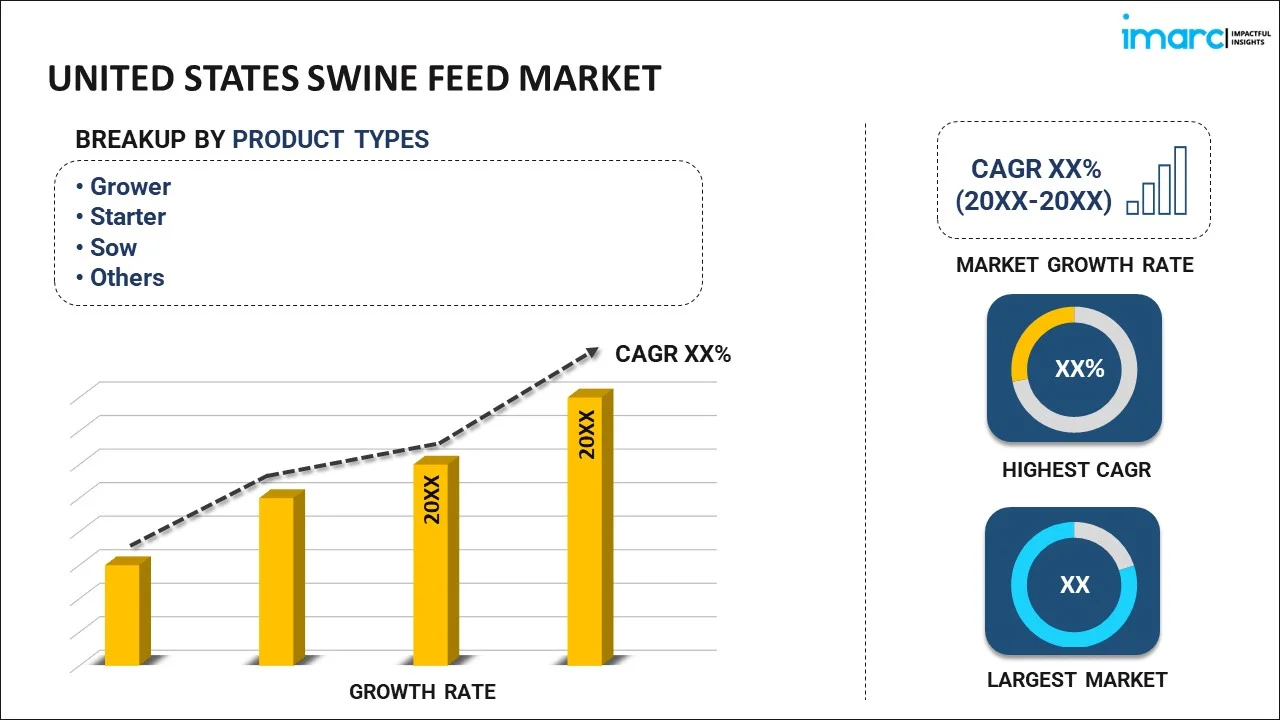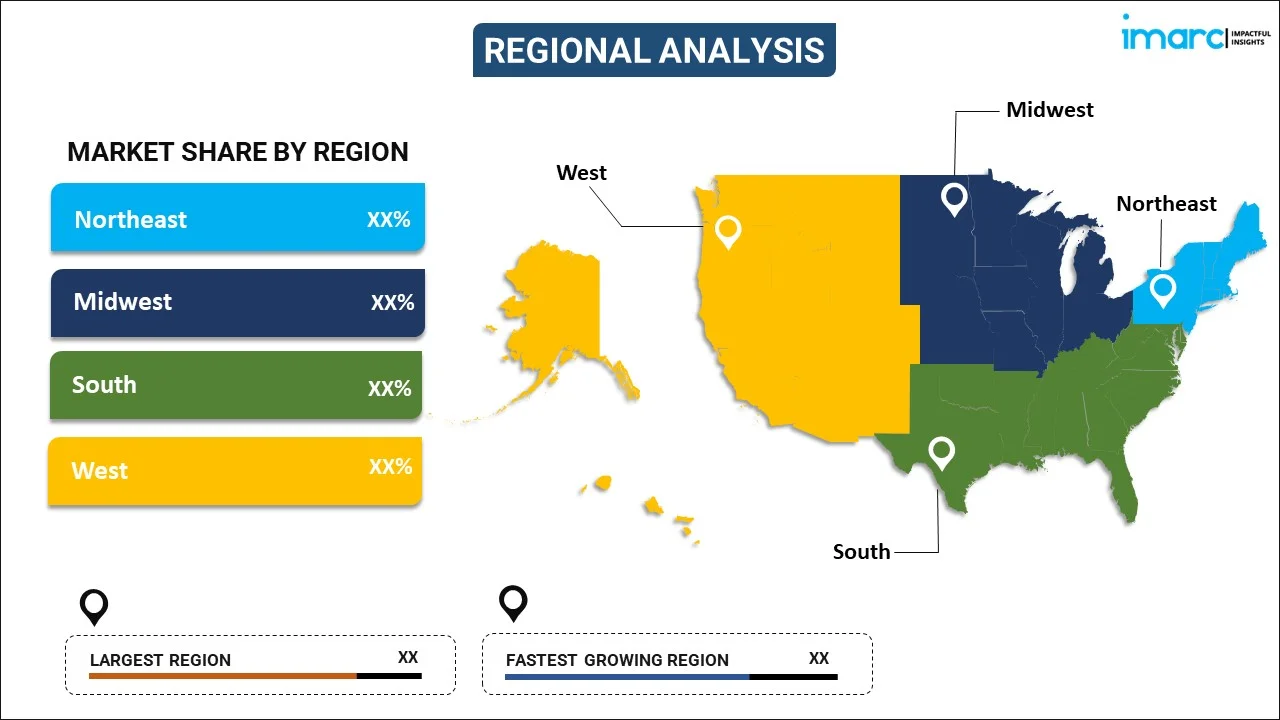
United States Swine Feed Market Report by Product Type (Grower, Starter, Sow, and Others), Feed Essence (Vitamins, Antioxidants, Feed Acidifiers, Feed Enzymes, Amino Acids, and Others), Feed Additive Type (Zootechnical Feed Additives, Sensory Feed Additives, Nutritional Feed Additives), and Region 2025-2033
Market Overview:
The United States swine feed market size reached USD 25,737.7 Million in 2024. Looking forward, IMARC Group expects the market to reach USD 38,668.8 Million by 2033, exhibiting a growth rate (CAGR) of 4.4% during 2025-2033. The market is drastically changing with the development of specialized nutrition, precision feed technology, and the inclusion of sustainable feed ingredients. Feed efficiency, animal health, and environmental stewardship are becoming important considerations for producers as they address changing consumer demands and regulatory requirements. New formulations and digitalization are enhancing productivity in all phases of swine production. The addition of alternative proteins and native additives also adds to this advancement, leading to a consistent growth in the United States swine feed market share.
|
Report Attribute
|
Key Statistics
|
|---|---|
|
Base Year
|
2024
|
|
Forecast Years
|
2025-2033
|
|
Historical Years
|
2019-2024
|
|
Market Size in 2024
|
USD 25,737.7 Million |
|
Market Forecast in 2033
|
USD 38,668.8 Million |
| Market Growth Rate (2025-2033) | 4.4% |
Swine feed refers to the dietary supplement for pigs, which is made of natural corn, soybean, and wheat ingredients. It is fortified with amino acids, essential fatty acids, vitamins, and minerals to meet the nutritional requirement of pigs. A wide variety of pellets and mash swine feeds are available in the market, which helps in improving the performance goals and herd health as they comprise proteins made of all-natural plant sources and natural fungal-based enzymes.
The United States swine feed market is primarily driven by the rising demand for pork, as it is cheaper, highly nutritious, and contains less fat and cholesterol compared to beef and other meat products. Additionally, changing regulations and policies in the country, coupled with the growing demand for animal protein, is providing a positive impact on the United States swine feed market growth. Moreover, extensive research and development (R&D) activities regarding the testing of new ingredients and feed formula to produce innovative and efficient swine feed variants are also bolstering the market growth.
United States Swine Feed Market Trends:
Nutrient Enriched and Specialty Feed Formulations
In the United States, swine feed producers are shifting their focus to nutrient-enriched and specialty formulations to maximize animal growth, health, and productivity. These diets are specially formulated to cater to precise dietary needs in various phases of a pig's life cycle, from weaning through finishing. Formulations typically contain essential amino acids, vitamins, minerals, organic acids, enzymes, and probiotics for improved digestion, immunity, and overall performance. As per the sources, in January of 2025, Layn Natural Ingredients launched water-soluble polyphenol feed additives for poultry and pigs. Formulated to be delivered through drinking water, the technology provides rapid, adaptable nutritional support to enhance animal well-being. Moreover, such high-end feed forms also have a significant role in minimizing the application of antibiotics, aligning with the increasing demand for antibiotic-free pork. As consumers' expectations shift toward clean-label and quality meat, manufacturers are embracing such specialized feeds to produce better carcass quality and feed efficacy. In addition, custom nutrition programs that are created with the input of veterinarians and animal nutritionists are becoming popular to tackle herd-specific health issues. These United States swine feed market trends underscores the transition from conventional bulk feeding to science-based, performance-enhanced feeding systems that balance both animal well-being and product quality.
Precision Nutrition and Digital Integration
The convergence of precision nutrition and digital technologies is transforming swine feed practices in the United States, allowing for a more precise, effective, and reactive method of pig feeding. Producers and farmers are increasingly using smart technologies like weight-measuring systems, automated feeders, and nutrient model software to tailor feed composition based on live animal data in real time. Such customization aids maximum growth with minimum waste and feed costs. By digitally tracking feed consumption, growth rates, and health measures, producers are able to make instant adjustments that improve feed conversion and lower nutrient imbalances. Precision feeding not only addresses economic efficiency but also contributes to sustainability objectives by decreasing environmental effects like nitrogen and phosphorus excretion. In addition, cloud-based systems now provide built-in dashboards for nutrition, health, and inventory management to enhance decision-making in all swine operations. Such a shift towards data-driven feeding solutions is a significant step in both operational management and long-term productivity for the swine sector.
Sustainable Ingredients and Environmental Responsibility
As per United States swine feed market analysis, sustainability has become a mainstream priority in the U.S. swine feed industry, with innovation occurring in both production practices and ingredient supply. Producers are increasingly adding non-traditional protein sources like insect meal, algae-based ingredients, and agricultural byproducts such as brewer's grains and soybean hulls to decrease reliance on traditional grain-based diets. These ingredients not only follow circular economy ideology but also result in lower land, water, and energy use. Besides, the use of natural additives like essential oils, prebiotics, and phytogenics is becoming increasingly accepted as a replacement for antibiotic growth promoters that promote both animal health and environmental objectives. Feed manufacturers are also focusing on low-carbon production strategies, logistics optimization, and research funding to create climate-resilient feed products. Regulatory requirements and consumer pressures to increase transparency in food production are further propelling this change. Overall, sustainability in swine feed extends beyond environmental stewardship as it is increasingly seen as a competitive advantage and a long-term commitment to responsible animal agriculture.
United States Swine Feed Market Opportunities:
The United States swine feed market demand offers a significant number of promising opportunities fueled by innovations in nutritional science, expanding demand for high-quality pork products, and the practice of sustainable farming practices. There is heightened interest in developing feeds that maintain animal health and productivity without using antibiotics, providing tremendous scope for natural additives like probiotics, enzymes, and organic acids. Emergence of precision livestock farming technology is also making more specialized, data-based feed management systems possible, providing opportunities for innovation in feed customization as well as monitoring. Moreover, growth in the potential for U.S. pork exports to create a demand incentive for producers to produce high-quality, high-nutrition products stimulates investments in high-end feed solutions. Sustainable sourcing and alternative protein ingredient inclusion have long-term advantages, both meeting consumer expectations and sustainability objectives. The combination of these elements suggests a strong growth potential, diversification in products, and increased competitiveness in the U United States swine feed market outlook.
United States Swine Feed Market Challenges:
Barring its growth opportunities, the market has a number of challenges that must be given attention and strategic adaptation. Volatility in feed cost, typically driven by volatility in grain and ingredient prices, is one major issue for producers who crave stable margins. Keeping up with changing regulatory needs—specifically around feed safety, antibiotic additives, and environmental concerns—can also be an operational drag. In addition, the transition to clean-label and sustainable products calls for improved traceability and transparency, with investments in supply chain infrastructure, certification, and formulation. Biosecurity risks and disease outbreaks further complicate feed management, and this calls for proactive health surveillance and back-up planning. According to United States swine feed market forecast, new technologies and precision nutrition solutions may prove challenging for small producers to implement due to resource or financial constraints. Blending cost-effectiveness, regulatory compliance, and innovation remains a sensitive balance for most stakeholders. The response to these challenges through careful planning and industry cooperation will be crucial to guaranteeing resilience and long-term viability.
Key Market Segmentation:
IMARC Group provides an analysis of the key trends in each sub-segment of the United States swine feed market report, along with forecasts at the country and regional level from 2025-2033. Our report has categorized the market based on product type, feed essence, and feed additive type.
Breakup by Product Type:

- Grower
- Starter
- Sow
- Others
Breakup by Feed Essence:
- Vitamins
- Antioxidants
- Feed Acidifiers
- Feed Enzymes
- Amino Acids
- Others
Breakup by Feed Additive Type:
- Zootechnical Feed Additives
- Sensory Feed Additives
- Nutritional Feed Additives
Breakup by Region:

- Northeast
- Midwest
- South
- West
Competitive Landscape:
The competitive landscape of the industry has also been examined along with the profiles of the key players.
Latest News and Developments:
- In January 2025, Resilient Biotics collaborated with Novus International in a joint development of a new swine feed solution aimed at respiratory health. The partnership will develop microbiome-inspired innovations that minimize respiratory risk and bolster immune strength, supporting Novus' vision to lead intelligent nutrition in the United States swine feed industry.
- In June 2024, Kemin Industries introduced FORMYL, a new feed acidifier for American swine producers. With encapsulated calcium formate and citric acid, the additive promotes gut health, aids in pathogen management, and enhances post-weaning digestion—providing a non-antibiotic alternative intended to increase swine productivity and feed efficiency in commercial operations.
- In June of 2024, KENT Nutrition Group introduced its Nexgen Advanced swine feed line, with more than 50 reformulated products. Supported by rigorous research, the new formulations eliminate fish meal, realign selenium levels, and include Chromax to enhance growth performance, feed efficiency, and profitability throughout all phases of swine production.
Report Coverage:
| Report Features | Details |
|---|---|
| Base Year of the Analysis | 2024 |
| Historical Period | 2019-2024 |
| Forecast Period | 2025-2033 |
| Units | Million USD |
| Segment Coverage | Product Type, Feed Essence, Feed Additive Type, Region |
| Region Covered | Northeast, Midwest, South, West |
| Customization Scope | 10% Free Customization |
| Post-Sale Analyst Support | 10-12 Weeks |
| Delivery Format | PDF and Excel through Email (We can also provide the editable version of the report in PPT/Word format on special request) |
Key Questions Answered in This Report
The United States swine feed market was valued at USD 25,737.7 Million in 2024.
We expect the United States swine feed market to exhibit a CAGR of 4.4% during 2025-2033.
The sudden outbreak of the COVID-19 pandemic had led to the implementation of stringent lockdown regulations across the nation, resulting in the temporary restriction on production and supply of livestock, feed, and feed ingredients, thereby negatively impacting the United States market for swine feed.
The increasing demand for organic pig meat, along with the introduction of new animal rearing practices and maintenance of high farming standards, is primarily driving the United States swine feed market.
Based on the product type, the United States swine feed market can be categorized into grower, starter, sow, and others. Currently, grower accounts for the majority of the total market share.
Based on the feed essence, the United States swine feed market has been segregated into vitamins, antioxidants, feed acidifiers, feed enzymes, amino acids, and others. Among these, amino acids currently hold the largest market share.
Based on the feed additive type, the United States swine feed market can be bifurcated into zootechnical feed additives, sensory feed additives, and nutritional feed additives. Currently, nutritional feed additives exhibit a clear dominance in the market.
On a regional level, the market has been classified into Northeast, Midwest, South, and West, where West currently dominates the United States swine feed market.
Need more help?
- Speak to our experienced analysts for insights on the current market scenarios.
- Include additional segments and countries to customize the report as per your requirement.
- Gain an unparalleled competitive advantage in your domain by understanding how to utilize the report and positively impacting your operations and revenue.
- For further assistance, please connect with our analysts.
 Request Customization
Request Customization
 Speak to an Analyst
Speak to an Analyst
 Request Brochure
Request Brochure
 Inquire Before Buying
Inquire Before Buying




.webp)




.webp)












